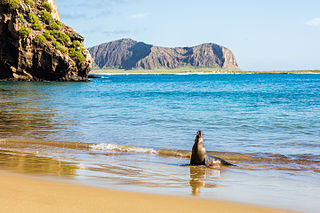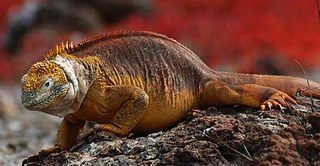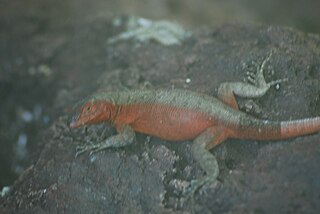
The Galápagos Islands are an archipelago of volcanic islands in the Eastern Pacific, located around the Equator 900 km (560 mi) west of South America. They form the Galápagos Province of the Republic of Ecuador, with a population of slightly over 33,000 (2020). The province is divided into the cantons of San Cristóbal, Santa Cruz, and Isabela, the three most populated islands in the chain. The Galápagos are famous for their large number of endemic species, which were studied by Charles Darwin in the 1830s and inspired his theory of evolution by means of natural selection. All of these islands are protected as part of Ecuador's Galápagos National Park and Marine Reserve.

Microlophus is a genus of tropidurid lizards native to South America. Around 20 species are recognized and 10 of these are endemic to the Galápagos Islands, where they are commonly known as lava lizards. The remaining, which often are called Pacific iguanas, are found in the Andes and along the Pacific coasts of Chile, Peru, and Ecuador.

Tropidurus is a genus of reptiles. The genus includes many species of Neotropical ground lizards. Tropidurus is the type genus of the family Tropiduridae.

The Galápagos hawk is a large hawk endemic to most of the Galápagos Islands.

The marine iguana, also known as the sea iguana, saltwater iguana, or Galápagos marine iguana, is a species of iguana found only on the Galápagos Islands (Ecuador). Unique among modern lizards, it is a marine reptile that has the ability to forage in the sea for algae, which makes up almost all of its diet. Marine iguanas are the only extant lizard that spends time in a marine environment. Large males are able to dive to find this food source, while females and smaller males feed during low tide in the intertidal zone. They mainly live in colonies on rocky shores where they bask after visiting the relatively cold water or intertidal zone, but can also be seen in marshes, mangrove swamps and beaches. Large males defend territories for a short period, but smaller males have other breeding strategies. After mating, the female digs a nest hole in the soil where she lays her eggs, leaving them to hatch on their own a few months later.
Bartolomé Island is a volcanic islet in the Galápagos Islands group, just off the east coast of Santiago Island. It is one of the "younger" islands in the Galápagos archipelago. This island, and Sulivan Bay on Santiago island, are named after naturalist and lifelong friend of Charles Darwin, Sir Bartholomew James Sulivan, who was a lieutenant aboard HMS Beagle.

The Galápagos land iguana is a very large species of lizard in the family Iguanidae. It is one of three species of the genus Conolophus. It is endemic to the Galápagos Islands, in the dry lowlands of the islands of Fernandina, Isabela, Santa Cruz, North Seymour, Baltra, and South Plaza.

Conolophus marthae, the Galápagos pink land iguana, is a species of lizard of the family Iguanidae. This critically endangered iguana is native only to the Wolf Volcano in northern Isabela Island of the Galápagos Islands (Ecuador). It has a pink body with some dark stripes, prompting some to call it the pink iguana or the Galápagos rosy iguana. The species was first discovered in 1986 and was identified as a separate species, distinct from the Galápagos land iguana, early in 2009. This species is the only example of ancient diversification in the genus Conolophus.

Microlophus delanonis, the Española lava lizard or Hood lava lizard, is endemic to the Galapagos island of Española. The species is commonly attributed to the genus Microlophus but has been attributed to the genus Tropidurus.

Microlophus albemarlensis, the Galápagos Lava lizard, also known as the Albemarle Lava lizard, is a species of Lava lizard. It is endemic to the Galápagos Islands, where it occurs on several islands in the western archipelago: the large islands Isabela, Santa Cruz, Fernandina, Santiago and Santa Fe, as well as several smaller islands: Seymour, Baltra, Plaza Sur, Daphne Major and Rábida. It is the most widespread of the Galápagos species of Microlophus, the others only occurring on single islands. Some authors however, consider populations on Santiago, Santa Cruz, and Santa Fe to be distinct species. The species is commonly attributed to the genus Microlophus but has been historically placed in the genus Tropidurus.

Microlophus bivittatus, the San Cristóbal lava lizard, is a species of lava lizard endemic to San Cristóbal Island in the Galápagos Islands. The species is commonly attributed to the genus Microlophus but has been attributed to the genus Tropidurus. They are currently under threat by invasive cats on the island. The lizard is also closely related to the Microlophus occipitalis which radiated off of the bivittatus.

Microlophus duncanensis, commonly known as the Pinzón lava lizard, is a species of lava lizard endemic to the Galapagos Island of Pinzón. Although currently classified in the genus Microlophus, it has also been assigned to the genus Tropidurus.

Microlophus grayii, also commonly known as the Floreana lava lizard, Gray's lava lizard, and Gray's Pacific iguana, is a species of lava lizard in the family Tropiduridae. The species is endemic to the Galapagos island of Floreana.

Microlophus pacificus, the common Pacific iguana, is a species of lava lizard endemic to the Galapagos island of Pinta. The species is commonly attributed to the genus Microlophus but has been attributed to the genus Tropidurus.

Microlophus habelii, commonly known as the Marchena lava lizard, is a species of lava lizard endemic to the Galapagos island of Marchena.

Microlophus occipitalis, colloquially known as the knobbed Pacific iguana, is a lizard included within the Tropiduridae family. It is a member of the Microlophus genus and thus also considered a lava lizard. The knobbed Pacific iguana is found primarily in Western Peru and Ecuador, lining the coasts. The habitats of the knobbed Pacific iguana can be considered to be both broad and diverse as they are typically found in many different places such as beaches, lomas, and all the way to desert regions. This diversity is furthered as these lizards can also be found in open areas, between rocks, or bushes.

The Santa Cruz lava lizard is a species of lava lizard endemic to the Galapagos island of Santa Cruz.

Microlophus barringtonensis or the Santa Fe lava lizard is a species of lava lizard or a population of Microlophus albemarlensis. It inhabits Santa Fe island in the Galápogos. It is the only lava lizard on Santa Fe. It is extremely common.
Pseudalsophis thomasi, or Thomas' racer, a species of snake in the family Colubridae. It is endemic to several islands in the Galápagos group.



















